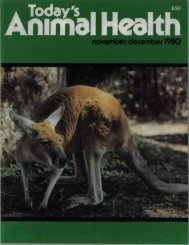aim
July-August 1972 - Animal Health Foundation
July-August 1972 - Animal Health Foundation
- No tags were found...
You also want an ePaper? Increase the reach of your titles
YUMPU automatically turns print PDFs into web optimized ePapers that Google loves.
a reptile<br />
By Carsten Ahrens<br />
Q<br />
Changes through the centuries in<br />
many groups of plants and animals<br />
have made these organisms more and<br />
more complex. The fossils of the<br />
modern horse, for example, show it<br />
was once a creature the size of a fox<br />
terrier, but it gradually evolved into<br />
the comparatively good sized draft<br />
animal of today.<br />
For reptiles, the story is different.<br />
Their glories are all in the past - the<br />
Age of Reptiles was in full swing<br />
approximately a hundred million years<br />
ago. During their Golden Age, they<br />
grew to be the biggest beasts that ever<br />
trod the earth; none since have ever<br />
compared. They were the giant reptiles,<br />
the dinosaurs, with vast bodies<br />
and tiny brains. Modern reptiles are a<br />
sorry remnant of these monsters of the<br />
past. Not only are there fewer species<br />
but there are fewer individuals, and<br />
even these are rapidly disappearing.<br />
Few people like reptiles. The<br />
farmer, who should be their best<br />
friend because reptiles live on man's<br />
enemies, frequently kills them whenever<br />
the opportunity permits.<br />
Reptiles of the world fall into five<br />
groups:<br />
1. TAUTARAS, 2. TURTLES, 3.<br />
LIZARDS, 4. SNAKES, 5. CROCO<br />
DILES and ALLIGATORS.<br />
The most primitive are the TAU<br />
TARAS found only in and about New<br />
Zealand. They're called "living fossils,"<br />
the last of their kind. We'll<br />
ignore them in this quiz.<br />
What do you know about TUR<br />
TLES, LIZARDS, SNAKES, and the<br />
CROCODILE/ALLIGATORS? Write<br />
in the name of the group referred to in<br />
each question :<br />
28<br />
Which group has some species<br />
that lay eggs and some<br />
species that give birth to live<br />
young?<br />
Which has members found<br />
farthest from the equator?<br />
Which has members found<br />
closest to the equator?<br />
Which group, if any, does<br />
not return to land to lay its<br />
eggs?<br />
Which group superficially resembles<br />
salamanders?<br />
Which group has a member<br />
that is said to "fly"? (Really,<br />
it only glides.)<br />
Which group lacks moveable<br />
eyelids?<br />
Which group has members<br />
that can lose the tail and<br />
grow a new one?<br />
To which group, if any, does<br />
the horned toad belong?<br />
To which group, if any, does<br />
the poisonous Gila Monster<br />
belong?<br />
Which group has members<br />
that can undergo radical<br />
color changes?<br />
, 12 The Chuckwalla, Flying<br />
Dragon, Iguana, Swift, Glass<br />
Snake (be careful) all belong<br />
to which group?<br />
, 13 Which group has no members<br />
that grow teeth?<br />
, 14 Which group has the heaviest<br />
members?<br />
, 15 Which group lives longest?<br />
16 Which group has its mouth<br />
cleaned of leeches by a plover<br />
bird?<br />
17 Which group grows to the<br />
greatest length?<br />
18 Which group once furnished<br />
material for great numbers<br />
of traveling bags?<br />
19 Which group can be the most<br />
noisy?<br />
20 Which group includes almost<br />
half of all the reptiles?<br />
21 Which are the best-known<br />
"leg-less" reptiles?<br />
22 Which group is terrestrial or<br />
arborial but not aquatic?<br />
23 Which group has as many as<br />
300 vertebrae in its backbone?<br />
24 Which group may change its<br />
skin several times a year?<br />
25 Which group has no external<br />
ears?<br />
REPTILE QUIZ ANSWERS:<br />
1. Snakes — black snakes lay eggs but<br />
garter snakes bring forth young.<br />
2. Turtles - wander farthest from the<br />
ancestral home, the equator. This is<br />
especially true of sea turtles.<br />
3. Crocodiles and Alligators - are<br />
strictly jungle animals.<br />
4. All reptiles are born with lungs;<br />
therefore the eggs are always laid on<br />
land.<br />
5.Lizards - but they have<br />
over-lapping scales while salamanders<br />
are scaleless.<br />
6. Lizards — some of them, "flying<br />
dragons," have folds of skin down<br />
their sides that make gliding possible.<br />
7. Snakes - a transparent skin covers<br />
the eyes. It's shed with the skin.<br />
8. Lizards — if one is caught by the<br />
tail, the predator may be left holding<br />
the tail while the lizard scurries<br />
away to grow a new one.<br />
9. Lizards — this desert animal has<br />
scales; it couldn't be a toad.<br />
10. Lizards — the Gilas of N. America<br />
are the only poisonous lizards in the<br />
world.<br />
11. Lizards — chameleons are the kings<br />
of color-changers; the American alligator-lizard<br />
can do some color magic<br />
too.<br />
12. Lizards - all of them, even the glass<br />
snake, belong here.<br />
13. Turtles — although none have teeth,<br />
the horny rim around the jaws<br />
makes a powerful vice of the mouth.<br />
14. Turtles — sea species are heaviest,<br />
often weighing over a thousand<br />
pounds. Their fossil ancestors were<br />
even heavier.<br />
15. Turtles — no one seems to know.<br />
Some turtles in the oldest zoos are<br />
as old as the zoos and are still going<br />
strong.<br />
16. Crocodiles and Alligators - when<br />
bothered by leeches, the beasts<br />
crawl out on a sandbar, open their<br />
mouths, and the birds fly in. The<br />
birds get their protein, the Crocs<br />
get relief, and everyone's happy.<br />
17. Snakes — boa constrictors grow to<br />
30 feet and more.<br />
18. Crocodiles and Alligators - time<br />
was when every traveling salesman<br />
had his "gator" bag . . .even "gator"<br />
shoes.<br />
19. Crocodiles and Alligators - during<br />
mating season the bellowing males<br />
can be heard for a mile or more<br />
across the jungle.<br />
20. Snakes — there are about 2,000<br />
species in the world.<br />
21. Snakes - their ancestors away back<br />
had legs, but their descendants get<br />
along amazingly well without 'em.<br />
22. Lizards — don't go down to the sea.<br />
They like farm and forest, even<br />
desert.<br />
23. Snakes — all these pairs of ribs, by<br />
pressing in turn on the ventral<br />
scales, help make a snake's movement<br />
possible.<br />
24. Snakes — this sometimes causes confusion;<br />
a rattlesnake gets a new<br />
rattle each time it sheds its skin.<br />
25. Snakes - like a fish, a snake has no<br />
sign of an outer ear. It can pick up<br />
the slightest land vibration, however.








